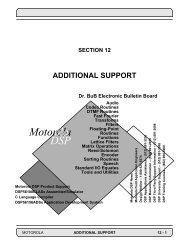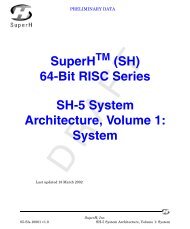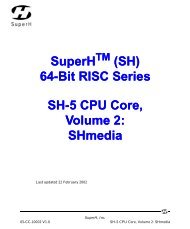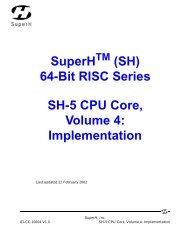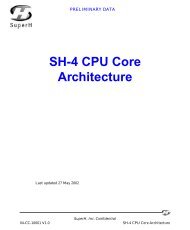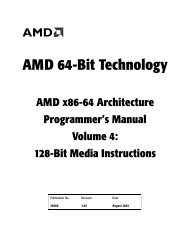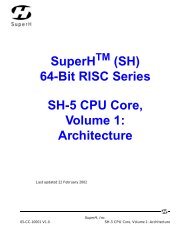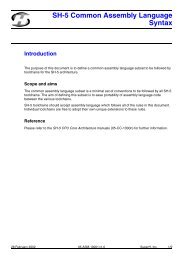SuperH (SH) 64-bit RISC Series SH-5 System Architecture, Volume ...
SuperH (SH) 64-bit RISC Series SH-5 System Architecture, Volume ...
SuperH (SH) 64-bit RISC Series SH-5 System Architecture, Volume ...
Create successful ePaper yourself
Turn your PDF publications into a flip-book with our unique Google optimized e-Paper software.
PRELIMINARY DATA<br />
120 Debug protocols and interfaces<br />
Each WP channel’s action register allows the type of trace message generated to be<br />
defined. See Section 1.5: Debug event actions on page 48.<br />
Encoding of address offsets<br />
To minimize the sizes of trace messages being sent over the <strong>SH</strong>debug link, program<br />
counter addresses, and bus analyzer addresses are compressed wherever possible.<br />
However, when the trace destination is configured as “DM FIFO trace hold”,<br />
“circular DM FIFO”, “circular trace buffer” or “trace buffer hold” mode, addresses<br />
are always encoded as absolute values. This allows trace to be reconstructed even if<br />
some trace packets are lost, as each message can be interpreted without reference to<br />
other messages.<br />
An encoding method is used whereby either one or two bytes are used to represent<br />
signed address offsets as either a 7-<strong>bit</strong> or a 15-<strong>bit</strong> 2’s complement value. These<br />
offsets are relative to the previous address of the same type. If the address cannot be<br />
expressed as an offset, an absolute 32-<strong>bit</strong> value is encoded instead. Therefore:<br />
• Program counter addresses are stored as effective addresses, and are encoded<br />
either as an 32-<strong>bit</strong> absolute address, or as a 7-<strong>bit</strong> or 15-<strong>bit</strong> 2’s complement value<br />
relative to the previous PC address.<br />
• Bus analyzer addresses are encoded either as absolute 32-<strong>bit</strong> addresses, or as a<br />
7-<strong>bit</strong> or 15-<strong>bit</strong> 2’s complement value relative to the previous bus analyzer<br />
address.<br />
Address offsets are calculated as [NEW_ADDRESS - PREVIOUSLY_SENT_ADDRESS]. As<br />
shown in Figure 5, <strong>bit</strong>-7 of the first byte is used to indicate whether a second byte<br />
follows.<br />
Absolute or relative encoding of an address is indicated by one of the following<br />
header fields:<br />
• PC_ABSOLUTE<br />
• SRC_ABSOLUTE (in branch trace messages only)<br />
D R A FT<br />
• DEST_ABSOLUTE (in branch trace messages only)<br />
• ADDR_ABSOLUTE (in bus analyzer trace messages only)<br />
When debug software is analyzing trace message information, it uses an absolute<br />
address as the reference for reconstructing the addresses in subsequent trace<br />
messages. The reference message (Section 1.8.6: Timestamping and reference<br />
messages on page 93 and Table 47 on page 133) also contains the absolute PC and<br />
<strong>SuperH</strong>, Inc.<br />
<strong>SH</strong>-5 <strong>System</strong> <strong>Architecture</strong>, <strong>Volume</strong> 3: Debug 05-SA-10003 v1.0



